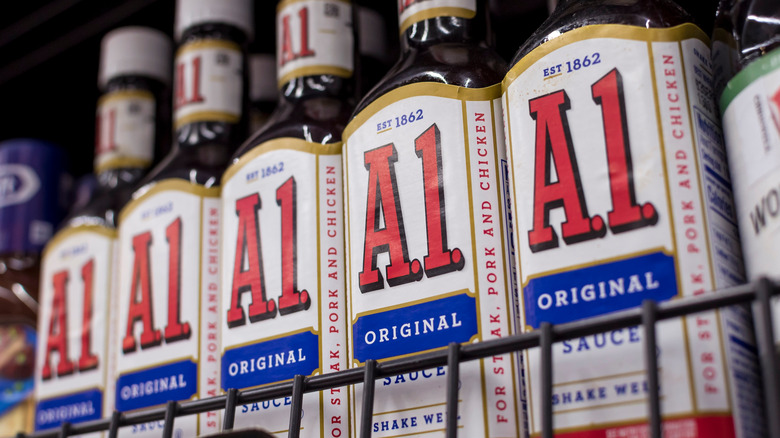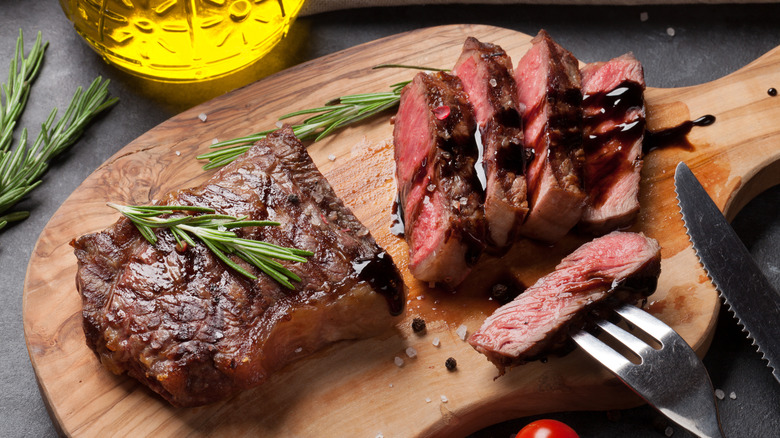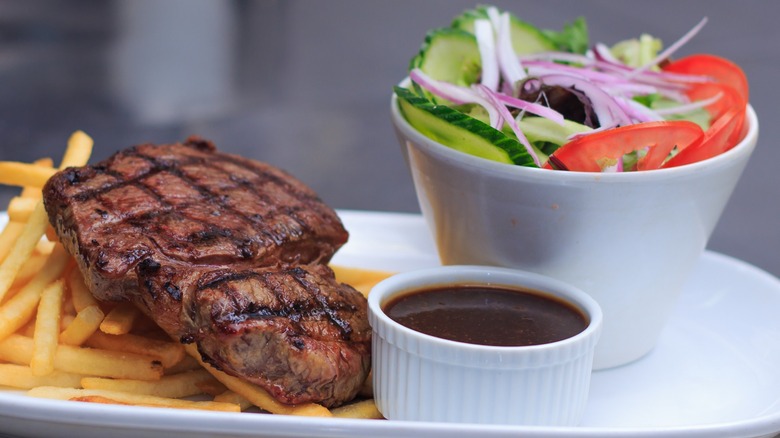This Ingredient Is Why A1 Steak Sauce Is So Popular
Steak sauce is a much-loved but sometimes maligned condiment. For instance, it's included on the list of words and phrases that must never be uttered when ordering steak at a restaurant that specializes in charred hunks of meat. Despite what detractors have to say about the matter, lots of people enjoy the savory, meaty flavor imparted by the condiment. And for many ardent lovers of steak sauce, one brand rules them all: A.1. If you've ever wondered what gives this sauce its characteristic flavor, which is often described as savory yet tart, the answer lies in an uncommon ingredient.
Along with components like tomato paste, vinegar, and dried garlic, A.1. sauce contains crushed orange purée. Compare this to Lea & Perrins, another popular steak sauce brand, and you'll find that orange purée is missing (while tomato paste, vinegar, and garlic all make an appearance). While orange purée is less common in steak sauce, orange is often paired with red meat. For example, orange beef is a popular Chinese American dish that combines the bright, acidic flavors of citrus fruit with the meaty, robust flavor of flank steak. The orange purée in A.1. sauce has a similar effect, which is likely why the condiment remains beloved by so many.
Acidity creates a more complex savory flavor
Anyone who's ever sampled A.1. is aware of the satisfying tanginess the sauce imparts, and this bright flavor could be attributed to the inclusion of orange. Orange purée is a welcome addition to savory sauce because it creates a more complex flavor than you get from the sauce alone. Citrus fruits also help tenderize meat, which creates a delectably juicy texture. Lemons and limes have a similar effect on meat, but their bold citrus flavor could be too powerful for a savory sauce. Conversely, oranges have a milder, sweeter flavor that melds with the other ingredients beautifully.
The label on A.1. steak sauce does not go into detail about the components of the brand's orange purée. However, orange purée usually includes all parts of the orange, even the peel and the pith (which is the white stuff that's attached to orange peels). Along with being crushed in a food processor, oranges are often boiled when making purée, which alleviates some of the bitter flavors found in the peel. Sugar may also be added, depending on the recipe.
A.1. sauce also works well on other foods
A.1. and steak might be a match in culinary heaven, but this sauce also pairs nicely with other foods. For instance, it makes an excellent addition to baked chicken wings and can even be combined with hot sauce for an extra bit of heat. Chicken loves spicy, tangy flavors, and the addition of orange purée in A.1. creates a more nuanced flavor profile than you would get from hot sauce alone. The big, meaty flavor of pork chops can also be enhanced by the tangy flavor of citrus-infused A.1. With this preparation, adding brown sugar to the sauce plays up its sweet-savory components, with the orange purée serving as the perfect complement to the sweetness.
A.1. also works with side dishes, according to a Reddit thread. After the OP recommended dipping fries in A.1., a commenter stated, "A.1. sauce on your baked potato is the best." And if you think that potatoes are a left-field suggestion, consider that steak sauces such as A.1. can even elevate egg salad. The magic of this condiment may lie in the inclusion of orange purée, an unexpected ingredient that has a major impact on the appeal of A.1.


